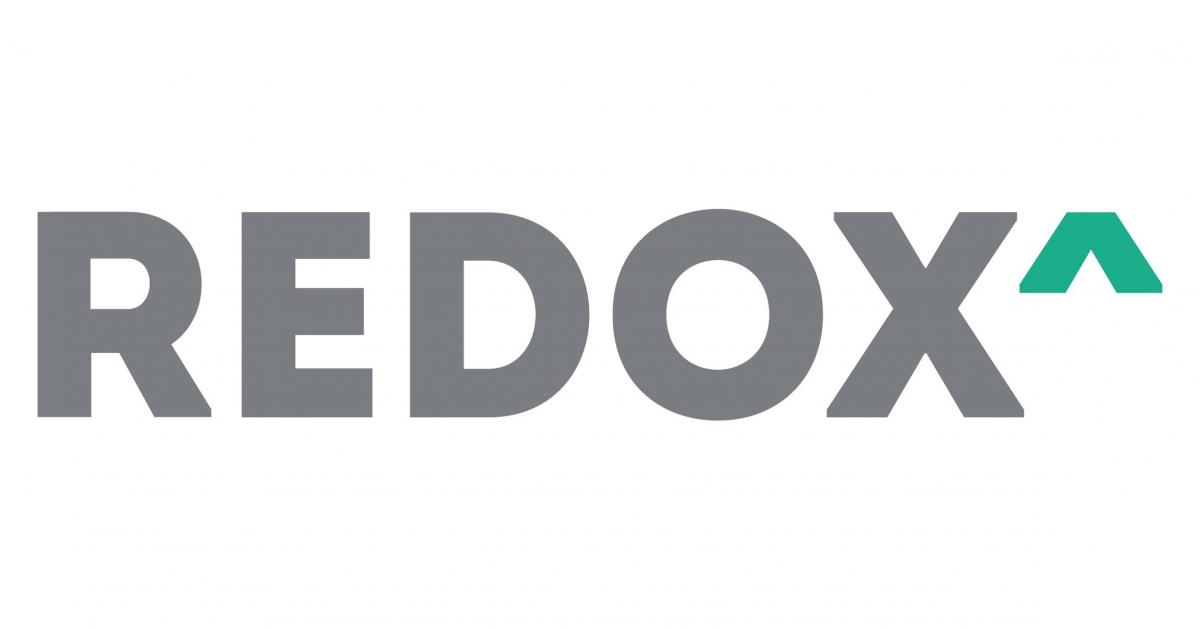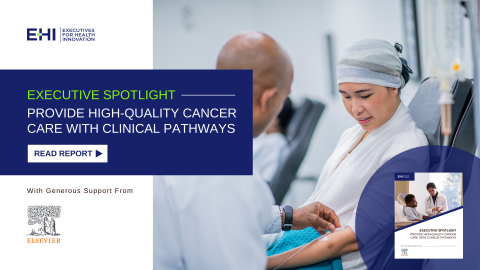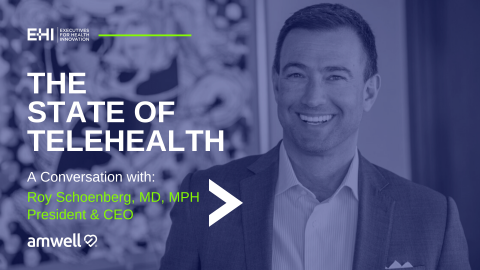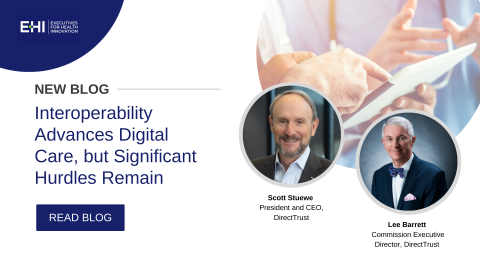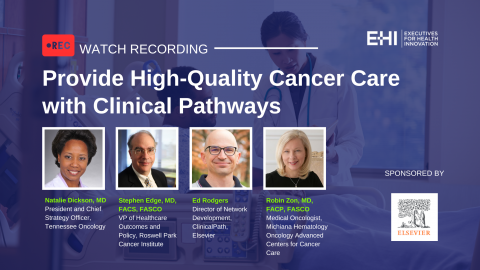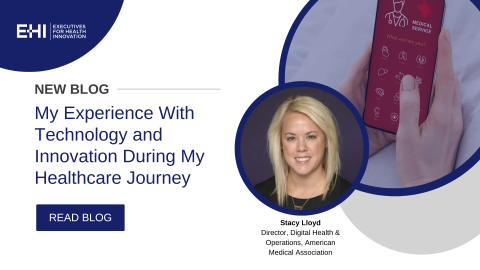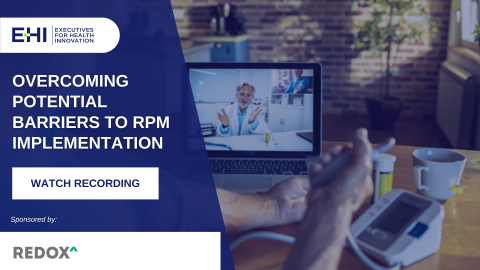EHI and Elsevier Release Report on Providing High-Quality Cancer Care with Clinical Pathways
Washington, DC – May 11, 2023 - Today, Executives for Health Innovation (EHI) and Elsevier released the report, Provide High-Quality Cancer Care with Clinical Pathways. This report highlights key takeaways from a recent EHI roundtable featuring oncologists and pathway experts on the appropriate use of clinical pathways in oncology and answering relevant questions around the topic from other oncology leaders.
Webinar: Overcoming Barriers: Capturing Clinical Data Using the Cloud
Cloud has been widely adopted across many industries. Gone are the days of fragmented legacy IT systems. Data is now on-demand analytics, and easily accessible and actionable through the cloud.
Executive Spotlight: Provide High-Quality Cancer Care with Clinical Pathways
Overview
Clinical pathways enable providers to deliver evidence-based healthcare to patients. They provide treatment guidance based on the latest research and support standardization of care. Oncology practices implement pathways to ensure care is at the highest standard of quality, access, affordability, and health outcome.
Executives for Health Innovation (EHI) convened a group of oncologists and pathway experts at an executive roundtable, followed by a public webinar. The group discussed the appropriate use of clinical pathways in oncology and answered relevant questions around the topic from other oncology leaders.
This report highlights key takeaways from those discussions.
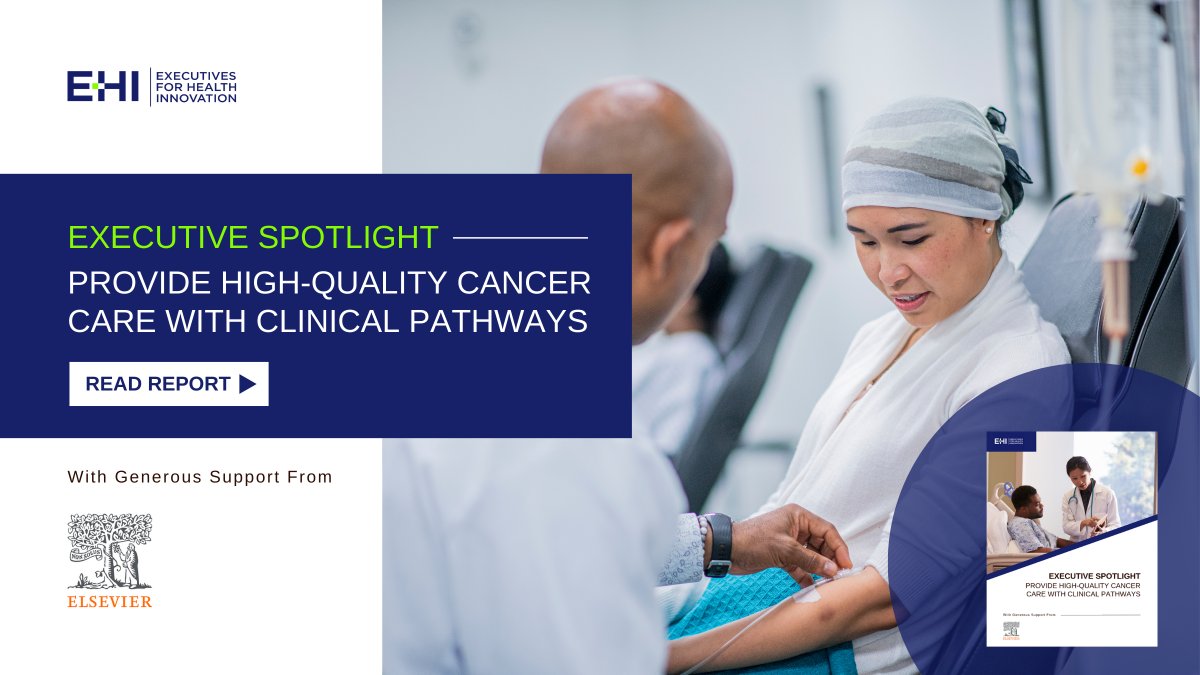
EHI thanks Elsevier for their generous support of our organization’s work addressing digital care and innovations improving health.

Interview: The State of Telehealth with Dr. Roy Schoenberg
During this timely interview, EHI CEO, Jen Covich Bordenick, spoke to Dr. Roy Schoenberg, president & chief executive officer of Amwell to address the current state of telehealth. Dr. Schoenberg gave his thoughts on what he believes the future of this dynamic technology looks like.
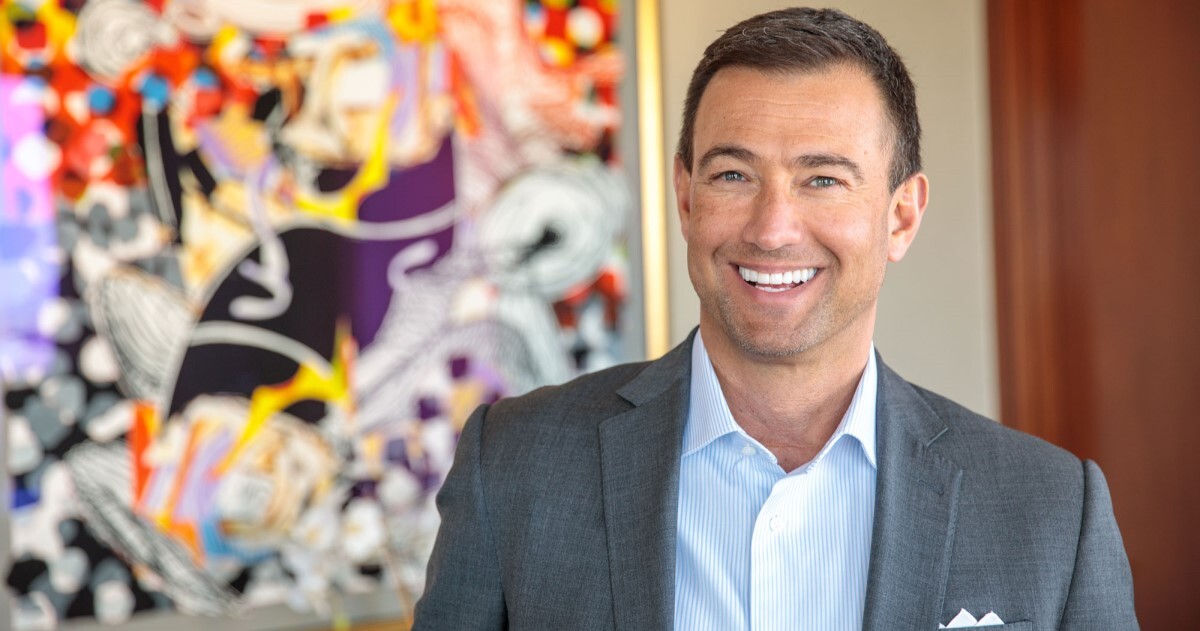
Roy Schoenberg, MD, MPH
President & CEO
Amwell
Dr. Roy Schoenberg is President and CEO of Amwell. Since co-founding the company with his brother Ido Schoenberg, Amwell has grown to become one of the largest telehealth eco-systems in the world, digitally connecting healthcare’s key stakeholders - payers, providers, and millions of patients in an efficient, modern healthcare experience. Prior to Amwell, Roy was the founder of CareKey and served as Chief Information Security Officer at TriZetto, following its acquisition of CareKey. In 2013, Roy was appointed to the Federation of State Medical Boards’ Taskforce that issued the landmark guidelines for the “Appropriate Use of Telemedicine in the Practice of Medicine”. Roy was named one of Modern Healthcare’s 100 Most Influential People in Healthcare in 2020 and is the 2014 recipient of the American Telemedicine Association Industry award for leadership in the field of telemedicine. An inventor at heart, Roy holds over 50 issued US Patents in the area of healthcare technology, speaks frequently in industry and policy forums, serves on the healthcare advisory board of MIT Sloan, holds an MD from the Hebrew University and an MPH from Harvard. He is a sailor, scuba-diver, and, between September and February, a devoted football fan.

Blog: Interoperability Advances Digital Care, but Significant Hurdles Remain
The prospect of truly interoperable patient health data leapt forward in February when the Department of Health and Human Services announced six entities in line to be qualified to serve as data exchange hubs.
If each interoperability step is a building block to the patient data equivalent of an interstate, this announcement forms a key connector for the nationwide data highway. But the interstate is nowhere near complete, so celebrations are premature. It’s a critical and encouraging step, to be sure, but connecting provider systems is a complicated business.
The healthcare industry remains a prime target for cybersecurity attacks, with 700 incidents in 2022 compromising 51.4 million patient records. Connecting networks across the country will exacerbate the vulnerabilities — unless sufficient care is taken at every step to ensure data protection and privacy.
Interoperability carries with it the possibility of transforming patient care and improving outcomes by expanding data access. Imagine accurate and up-to-date data flowing among caregivers as a patient moves from care setting to care setting, provider to provider, with providers and staff spending less time locating, aggregating, and digesting data and more time on direct patient care. Free-flowing data eliminates much of the paperwork patients must fill out over and over again.
Yes, the promise of interoperability is real and exciting, and the healthcare industry is closer than ever to achieving this elusive aim. The next steps will be equally as critical in making interoperability a reality that serves both providers and patients.
Interoperability Will Improve Patient Care Outcomes
Imagine the all too frequent example: an individual is transported to the local emergency department after an automobile accident and needs immediate surgery. They are unresponsive, and their driver’s license indicates the individual is not local. Personnel can’t find in case of emergency (ICE) information on their phone, and there was no one else in the vehicle who could provide any medical details.
The patient needs immediate surgery, but any procedure could be deadly absent information about medical conditions such as whether the patient is taking blood thinners or has comorbidities that could impact the surgery and outcome. But the patient cannot wait, so the surgery proceeds.
Now imagine the same scenario with national interoperability of patient records. With a driver’s license, personnel quickly locate the patient’s record, see the patient isn’t taking a blood thinner and doesn’t have comorbidities that could affect the needed surgery, which proceeds in full knowledge of the person’s health status.
A patient doesn’t need to suffer a life-threatening accident to fall victim to bad or incomplete information. In 2017, the Joint Commission issued a Sentinel Event Alert on the potential for patient harm arising from insufficient patient handoffs. Caregivers along the continuum must understand a patient’s condition, treatment, medications, comorbidities, and more to start the next step on a patient’s care journey. Federal mandates for admission, discharge, and transfer (ADT) notifications are helping in this area. There’s no doubt interoperability can make those handoffs more meaningful and improve overall patient outcomes.
Meaningful Data Exchange Closer than Ever
The Trusted Exchange Framework and Common Agreement (TEFCA) was born out of the 21st Century Cures Act, passed on a bipartisan basis in the closing days of the Obama administration. The legislation did several things, including defining and making information blocking illegal and allowing patients to access their health data through application programming interfaces (APIs) and an “app of their choosing.” It also set up the initial framework for TEFCA, although the first draft of guidelines wasn’t released until 2018.
Even before the Cures Act, the industry was moving toward interoperability on its own. Providers in geographic areas were coming together to form local, regional, or state health information exchanges (HIEs), and health systems were promoting interoperability among member facilities. The CommonWell Health Alliance got its start in 2013, with the intention to build a shared infrastructure for members, followed a few months later by Carequality and its common standards used by vendor-based networks. In 2015, CommonWell and Carequality created a bridge allowing exchange between the two.
The culminating action for TEFCA is the application acceptance of the first qualified health information networks (QHINs) in February: CommonWell, eHealth Exchange, Epic TEFCA Interoperability Services, Health Gorilla, Kno2, and KONZA National Network. Together the prospective QHINs cover all 50 states, conducting billions of transactions for most hospitals and tens of thousands of providers. The final approval and ramp-up process is expected to take a year.
National Coordinator for Health IT Micky Tripathi also recognized the next big challenge, saying that “strong privacy and security protections are required of QHINs.” He noted that greater interoperability “will help improve the quality, safety, affordability, efficiency, and equitability of health care across the country.”
Data Duplication, Integration Issues Still to be Solved
Getting QHINs up and running will not completely solve the interoperability challenge, for several reasons. Data duplication is the first issue that needs to be tackled. Think about the new patient paperwork completed on a first visit and then annually, multiplied by the number of physicians, specialists, and facilities that a patient visits. Who remembers what year that surgery took place or what Grandpa died from and when? When presented with duplicative information that may be contradictory, what takes precedence?
The provider experience also cannot be overlooked. The goal is to bring data together and present it in a way that’s useful for providers. However, providers are notorious for dis-adopting technology that doesn’t conform to their workflows. How many times has the death knell tolled for the fax machine amid technology advances designed to transmit data more reliably and securely?
Although the industry is moving toward value-based care, we aren’t there yet. In a fee-for-service environment, exchanging data with other providers is often seen as “leakage,” as patients move among providers and care settings.
At this time, interoperability is essentially voluntary. The federal government used financial incentives to achieve the widespread adoption of EHRs and e-prescribing. Until financial incentives are provided for interoperability, adoption may lag.
Cyber Threats Undermine Trust and Inhibit Exchange
One of the most pressing issues slowing widespread interoperability is the security of networks that will exchange data. A research brief from the ONC shows many organizations already have multiple connections to other data networks, with 6% reporting four or more connections. That doesn’t include the connections among provider systems, which can number in the hundreds for a single hospital.
Every data connection opens up another possible penetration point for hackers and bad actors. Health data is highly prized, and the average cost of remediation among healthcare organizations passed $10 million in 2022 — twice the cost of financial services, the second-most breached industry. Because of significant payouts, cyber insurance companies are tightening coverage requirements, and we believe insurers soon will routinely require third-party risk management to attest to the security of a hospital’s network infrastructure, including devices and business associates.
It's not a question of if an organization gets breached: It’s a question of when and how significant the impact will be on patient care. Organizations must have appropriate and rigorous policies and procedures in place. Ideally, they would be certified by a third party based on cybersecurity standards adopted by the National Institute of Standards and Technology.
Among trusted communication methods, sending and receiving data using Direct Secure Messaging (often called Direct) over the DirectTrust network operated by accredited organizations had the most universal usage, with adoption by 90% of hospitals. Direct is a proven technology that serves more than 282,000 organizations. In Q4 2022, 213 million messages flowed through the DirectTrust network. It is the inherent security of the protocol itself and the certification of network operators that has enabled such broad adoption.
The final unanswered question is how consumers will access their own data while maintaining privacy and security. App developers are governed by the Federal Trade Commission, not HIPAA, so it’s critical the right guardrails be developed so patients can confidently access their data. DirectTrust is working with The CARIN Alliance, a consumer-directed data exchange collaborative, on a new accreditation program to help bring that confidence to consumers.
Conclusion
The naming of the first QHINs represents a giant step forward for the interoperability and access of patient data. But the data exchange highway isn’t yet complete. The healthcare industry needs continued diligence to solve the remaining issues, including how to maintain the privacy and security of data as it flows through an increasing number of IT networks.
Third-party certification can provide the right security guardrails by setting high, yet achievable standards around IT networks and their ability to access and exchange data.
About the Authors
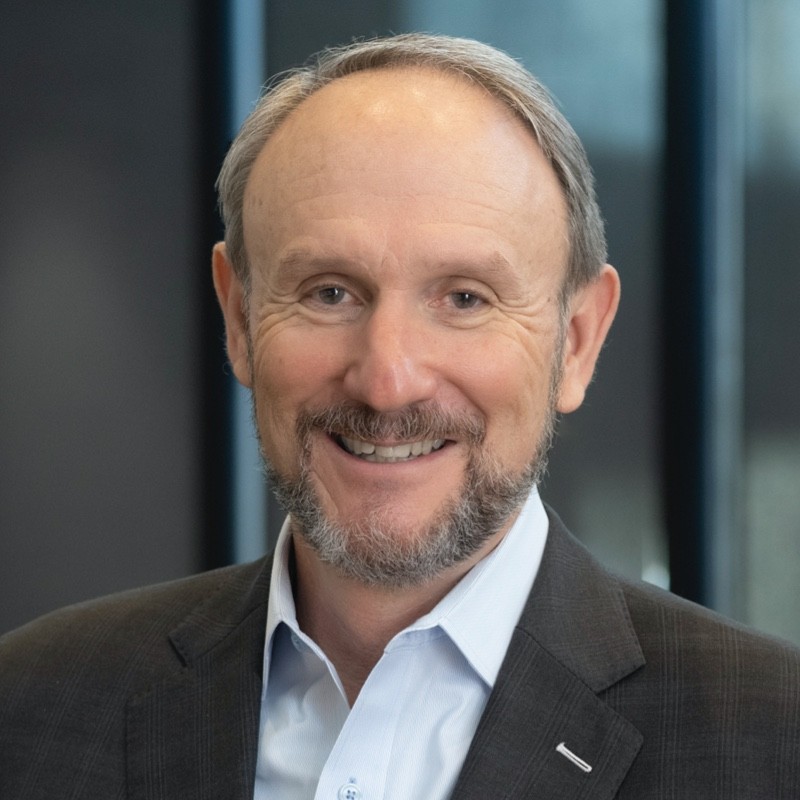
Scott Stuewe
President and CEO
DirectTrust
Scott Stuewe is a 25+ year veteran of the healthcare information technology industry. As President and CEO of DirectTrust, Scott drives visibility and utilization of the Direct Standard™ to contribute to nationwide interoperability. Under his tenure, the organization achieved the landmark milestones of one, two, and three billion Direct Secure Messages sent and received over the DirectTrust Network. Previously, Stuewe was Director of Strategy and Interoperability at DataFile Technologies, a health information management company, and served more than 24 years at Cerner, including as Cerner Network’s Director of National Interoperability Strategy, where he drove participation in the CommonWell Health Alliance and the bridge with Carequality.

Lee Barrett
Commission Executive Director
DirectTrust
Lee Barrett is the Commission Executive Director for DirectTrust. He previously served as CEO and Executive Director of the Electronic Healthcare Network Accreditation Commission (EHNAC), which merged into DirectTrust in January of 2023. He was appointed by the Office of the National Coordinator for Health Information Technology (ONC) as FAST co-lead of the Testing and Certification Tiger Team and as a member of the Executive Committee. Barrett currently serves as a member of the HHS 405(d) Cybersecurity Information Sharing Act (CISA), the FAST/HL7 Accelerator, the Healthcare Sector Cybersecurity Council (HSCC), and the EHI Leadership Council, and is also a board member for The Sequoia Project and co-chair of the Sequoia Interoperability Matters Leadership Council.
Webinar: Provide High-Quality Cancer Care with Clinical Pathways
Overview
New treatments for cancer care are emerging every day. Keeping current with all the new research, clinical trials, and drug information is a challenging task. As an oncology leader, you need to support your physicians’ decision making without sacrificing their autonomy.
Integrating evidence-based decision-support tools, like pathways, into the clinical workflow can assist oncology providers in their quest to provide high-quality care that puts the patient first. With the help of clinical pathways, providers and care teams can make consistent, well-informed decisions guided by the latest evidence-based research.
What
While clinical pathways enable predictability, profitability, and consistency within oncology practices, there can be adoption challenges. During this webinar, you’ll hear from oncology leaders who have had success in implementing clinical pathways to streamline treatment and enhance their programs. This webinar will address the following topics:
- Types of oncology patients and treatments that are best supported by clinical pathways.
- How to address adoption challenges with providers.
- Enhanced patient outcomes that some organizations have seen as a result of implementing clinical pathways and supporting critical research.
- How clinical pathways help providers meet and support goals of care for each patient.
Speakers will share data and real-world experiences and attendees will have an opportunity to ask questions and engage with the speakers.
Featured Speakers:
- Natalie Dickson, MD, President and Chief Strategy Officer, Tennessee Oncology
- Stephen Edge, MD, FACS, FASCO, VP of Healthcare Outcomes and Policy, Roswell Park Cancer Institute
- Ed Rodgers, Director of Network Development, ClinicalPath, Elsevier
- Robin Zon, MD, FACP, FASCO, Medical Oncologist, Michiana Hematology Oncology Advanced Centers for Cancer Care
Sponsored by:

Blog: My Experience With Technology and Innovation During My Healthcare Journey
As I think about the patient experience and how it’s evolved over the years, I am optimistic about the continued transition away from patient satisfaction scores on a Press Ganey survey and towards a more holistic approach to thinking about how patients and caregivers navigate, access, use and experience the broader healthcare system. Patient experience was a priority for many health systems prior to the COVID-19 pandemic, but the way care is delivered has drastically changed since then, and so have patient expectations.
Improving the patient experience is personal for me. At the age of 10, I was life-flighted to Children’s Hospital of Pittsburgh with a blood pressure of 240/120. I would soon be diagnosed with Pheochromocytoma, a type of tumor found on the adrenal glands that causes hypertension and various other symptoms. I spent a majority of the next month in the hospital being stabilized, followed by a 12-hour surgery to remove two tumors. Following another 10-hour surgery for a similar tumor three years later, my family was sent to the National Institutes of Health for further testing.
I was officially diagnosed with a rare, genetic disease called Von Hippel-Lindau (VHL), which causes people to grow tumors in up to ten (10) areas of the body. There’s currently no cure and surgery is the most common form of treatment (if and when it’s possible). This diagnosis started a trajectory that would change my life forever and truly require me to rely on the healthcare system for the rest of my life. Since those early years, eight (8) other members of my family have been diagnosed with VHL, I’ve had two (2) additional related surgeries, and I complete annual surveillance that includes MRIs, CTs, blood work, eye exams, etc.
The use of healthcare technology and innovation is a critically important aspect of care delivery for patients, and it has and will continue to play a major role in my healthcare journey. While I got sick at a time that healthcare tech consisted of EHRs at best, as I’ve gotten older and the industry has evolved, digital health has become a regular in my care routine in a few ways.
Tools that help coordinate care
I’ve moved across states multiple times and have had to identify new care teams. I’ve leveraged patient portals to access, secure, and/or share my medical records with new clinicians ahead of my first visit. Patient portals have also been a helpful way for me to remain engaged by viewing my results and comparing them against past years, and have made it easier to request appointments and/or ask questions to my physicians. Digital front doors can provide positive experiences for patients if done right and truly support patients in navigating the system.
I have also used a tool that records conversations with my physician to refer back to later. The app provides transcription of the visit that helps break down the medical terminology, provides information on potential prescription and pharmacy options for medications, and helps me identify questions that may come up after the visit. This can be a powerful tool to be able to share information with family members and for patients with new diagnoses.
Virtual care options
The expansion of telehealth in 2020 was a welcome resource for many patients, including myself, to continue to seek care when offices were closed. Being able to still receive my annual surveillance screening gave me peace of mind in a stressful time. Telehealth has also emerged as a way to expand access to clinical experts within centers of excellence across rare and complex health conditions creating opportunities for improved, coordinated, quality of care, especially across the VHL community. That access to virtual care has become an expectation and frankly, a lifetime, for many patients.
Remote monitoring has also been a crucial part of my healthcare journey. As a result of my disease, I am prone to high blood pressure. Being able to access validated devices that can accurately take BPs at home and report back to my physician supports a more comprehensive understanding of my health outside of the four walls of a clinic. Continued expansion of remote monitoring will provide opportunities for patients to be more engaged in their care, reduce trips to the doctor’s office, and hopefully provide better overall outcomes.
Healthy lifestyle support
Digital health for wellness isn’t always a part of traditional patient experience discussions because there is little integration with the actual health care system, but it is worth mentioning as it’s an important area of digital health that many patients are using independently to manage diet, exercise, sleep and other lifestyle behaviors. For me, it is an important component to my healthcare journey to ensure I’m doing everything I can do to stay healthy and be ready to manage any challenges with my VHL.
An area I have not personally had to experience (yet), but I am excited to see expanding is the decentralized clinical trial space. Clinical trials have historically lacked access and diversity, and this is a step in the right direction that can make a difference for so many patients that would have otherwise not had access to life-saving treatments.
My experience truly just scratches the surface of how digital health can positively impact the patient experience. There has been a significant amount of progress in digital health, but there’s still work to be done to realize it’s full potential. Key opportunities I’m interested in include enhanced care coordination support, expansion of access, and more personalized approaches to treatment and care for patients. There is also some “low hanging fruit” in the administrative areas of the healthcare system that could transform the patient experience, for example, obtaining medical records, scheduling appointments, cost transparency, and support understanding and paying bills.
Unfortunately, for most, healthcare experiences are still clunky, manual, and frustrating, even for the savviest of patients. The key to continuing to make progress in improving patient experiences across the industry is to listen to and incorporate the patient voice into the design, development, and implementation of products, solutions, and services.
About the Author:
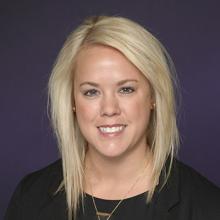
Stacy Lloyd
Director, Digital Health & Operations
American Medical Association
Stacy Lloyd is currently the Director of Digital Health and Operations at the American Medical Association. She has over 15 years of experience in finance and operations, digital health, innovation, and patient advocacy at leading healthcare organizations. Stacy also holds a Bachelors in Business Administration from Duquesne University and a Masters in Public Health from the University of Illinois at Chicago, and is a Board Certified Patient Advocate.
Stacy was diagnosed with VHL in 1999 at the age of 13. Since then, several other members of her family have also been diagnosed with the disease. She is personally and professionally invested in the future of healthcare and enjoys being a resource in this space for family, friends and other patients, so that they can be better informed and empowered in their own healthcare journeys.
EHI Release Report on Upcoming Cybersecurity Legislation
Washington, DC – January 12, 2023 - Today, Executives for Health Innovation (EHI) released the report, Executive Spotlight: A Deep Dive Into Upcoming Cybersecurity Legislation With Healthcare Executives.
Webinar: Provide High-Quality Cancer Care with Clinical Pathways
During this webinar, you’ll hear from oncology leaders who have had success in implementing clinical pathways to streamline treatment and enhance their programs.
Webinar: Overcoming Potential Barriers to RPM Implementation
Overview
While remote patient monitoring (RPM) has exploded in recent years, many providers are not equipped to purchase, set up, or manage RPM devices (especially multiple RPM solutions), not to mention the access and reimbursement needed to incentivize wide adoption. Clinicians are already time-constrained and creating additional administrative tasks would sacrifice other important office work or patient care.
How do we overcome this? How can we deliver a beneficial RPM experience while easing the burden a program could potentially place on physicians, staff, and patients? This online event covered solutions available to support providers with device setup, enrollment, and patient support.
Covered Points:
-
How are organizations looking to expand their programs as RPM solutions improve and become more reimbursable?
-
What are the processes for selecting which RPM solutions to implement?
-
What are the technical challenges being encountered as organizations implement more RPM?
-
How are organizations navigating technical challenges?
Featured Speakers:
- Beth Friedmann, RN, MSN, MA, AVP, Clinical Informatics, Northwell Health
- Colin Wearring, Sr. Product Manager, Redox
Sponsored by
